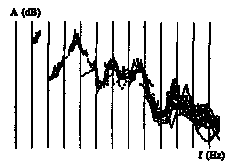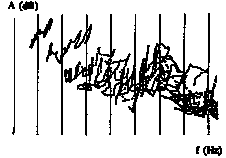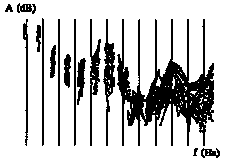
Tous droits réservés pour tous pays. All rights reserved.

 | Serveur © IRCAM - CENTRE POMPIDOU 1996-2005. Tous droits réservés pour tous pays. All rights reserved. |
ICMC 94, Aarhus (Danemark)
Copyright © Ircam - Centre Georges-Pompidou 1994
Thirty-nine minutes of high quality processed singing have been created for a CD of the soundtrack, produced by Audiovis [Audiovis, 94].
In the following sections we explore some of the issues by describing the characteristics of castrati voices and the practical constraints of the film project. Then, we detail the chosen solution and the specific processing used to make such a voice.
Castrati were generally well known for the special timbre of their voices : due to the surgical intervention they had undergone, their voices had not changed with puberty. Furthermore, with maturity, castrati lung capacity, chest's size, physical endurance and strength were generally greater than those of normal male [Sauvage et al., 84]. Consequently, they were able to sing very powerfully. Farinelli could sustain a note longer than one minute and he could sing long phrases of more than two hundred notes without seeming to take a breath. Their small and supple larynx along with their short vocal cords, allowed them to vocalise in a large range (up to three octaves and a half) and to sing with a great vocal flexibility (they could sing large intervals rapidly, cascading scales and trills). Furthermore, castrati were selected among the best child singers and trained very intensively.
As castrati's specific repertoire takes their expert singing technique into account, this repertoire is extremely difficult to sing. Some pieces of music are interpreted today but they are chosen for their simplicity or are played at a lower tempo.
Another difficulty in recreating a castrato voice is the lack of recorded references. The last occidental castrato has recorded less than one hour of singing on wax cylinders between 1902 and 1904 [Moreschi, 88]. This historical recording has very little technical utility due to its extremely poor quality.
Nevertheless, we can take into account the physical characteristics of the whole vocal production system of the castrati, the global aesthetic of the historical recording and descriptions found in the literature. On the other hand, the design of the final processed voice is conditioned by the wishes of the film and music producers. The definitive choice concerning the timbre of the voice is a compromise between the two preceding constraints.
Scores are difficult to interpret and parts of them can not be sung by contemporary singers anymore, due to the large range of the castrati. Thus it is necessary to use two complementary voices to cover the entire range and compensate for technical difficulties.
The recording was made in the concert hall "L'Arsenal" in Metz, France with the orchestra "Les Talens Lyriques", conducted by Cristophe Rousset. Due to artistic constraints, sound engineer Jean Claude Gaberel recorded voice and orchestra simultaneously, despite the evident interest of a multitrack recording. One consequence is the presence of orchestra components at 20 to 30 dB under the mean average level of the singing voices. This drastic constraint imposed a certain robustness to our processing method. Technically, the recording was made on a Nagra IV-D machine with a precision of 20 bits.
The editing has been made by Jean Claude Gaberel on a Sonic solution machine. This remarkable work often reached the note-by-note editing level.
To conclude, we should notice several points inherent to the use of two singers: The perceived dynamic is different between them and one can sometimes hear in the middle of a phrase unnatural discontinuities which sound like phrase attacks.
The chosen strategy (Cf. figure 1) can be divided in two steps:
First, since one of the artistic specifications was to make the finally processed voice sound close to the counter-tenor one, we modified the coloratura-soprano parts to match the counter-tenor timbre. This procedure, which we call voice morphing, constitutes the main and critical step of the scheme.
Secondly, we gave the voice a more juvenile aspect by using global modifications. For instance, we attenuated some high frequency bands to reduce the kind of breathiness found in Derek Lee Ragin's voice. We also made the voice sound brighter by modifying the spectral envelope.
Due to the great predominance of vowels over consonants, we only
processed the vowels. As vowel timbre is not only a function of phonemes but
also of pitch and intensity, a specific processing has to be applied to each
vowel note. Thus, a reference data base composed of all the combinations
phoneme-pitch-intensity of the counter-tenor voice had to be set up. Phonemes
are represented by spectral parameters which will be detailed further. Since
song texts are written in italian language, we only use the five following
phonemes /a/, / /, /i/, /o/, /u/. Pitch are chosen chromatically from
185 Hz to 987 Hz and intensity has only three levels:
piano, mezzoforte and forte.
/, /i/, /o/, /u/. Pitch are chosen chromatically from
185 Hz to 987 Hz and intensity has only three levels:
piano, mezzoforte and forte.
For practical reasons, the data base does not cover the entire intensity range. To complete it, we used intensity rules [Rodet et al., 89] to compute the missing fields.
Once the data base of the reference voice had been built, the musical phrases to be processed had to be segmented in order to label elementary portions in terms of singer, phoneme, pitch, power, begin and end time. Precise pitch estimation was made by the new frequential method described in [Doval, 94]. A first segmentation pass was performed automatically on the fundamental frequency evolution [Cerveau, 94]. Then, a second pass was performed by hand on the signal to adjust the begin and end time of the vowels and to give the singer and phoneme labels.

Figure 1: General Synopsis of the voice processing.
The basic idea of our voice morphing technique consists in modifying the spectral envelope of the soprano voice to match that of the counter-tenor voice. This is achieved by a frequency domain filtering through a phase-vocoder [Depalle et al., 91] (Cf. figure 1). But we use a more refined technique which is described now.
Since the scores we use are written for castrati, most of the songs are high-pitched, and it's a common fact that in this case the frequency response of the vocal tract is poorly estimated. This is particularly true in the low frequency range (below 2.5 kHz) where partials are widely spaced and formants are very narrow. The first consequence of bad estimation is that voice morphing does not reach the reference timbre; another consequence, which is specific to our context, is that transformation may emphasise some partials of the orchestra.
One possible solution to improve the estimation of the spectral envelope in the low frequency range is to use time evolution of frequency and amplitude of the partials, which scan the spectral envelope as can be seen in figure 2.
Thus, a method which estimates a spectrum envelope model by minimising its distance to the set of frequency-amplitude points, such as the discrete cepstrum [Galas, 90] could be considered.
But in practice the spectral envelope is not always stable during a vowel note. First, the coloratura-soprano often changes continuously the shape of her vocal tract when singing a cascade of notes on the same vowel (Cf. figure 3).
In addition, tremolo correlated to the vibrato effect induces a variation on the amplitude of each partial, which superimposes on the scanning of the spectrum envelope (Cf. Figure 4).
In the middle (2.5 to 5 kHz) and upper frequency range (greater than 5 kHz), the estimation of the spectral envelope remains valid, because of the wider shape of the formants. But if the spectral envelope shape is still constant for a given vowel note, its global amplitude is modulated and fluctuates according to the tremolo. Moreover, this effect is emphasised by the loudness. Finally, in the upper frequency range, the average level is perceptually more important than the precise shape of the spectrum.
A (dB)

Figure 2 : Time-trajectories of the first ten partials in the
Frequency-Amplitude plane, for the phoneme / / sung by the coloratura-soprano.
/ sung by the coloratura-soprano.
A (dB)

Figure 3 : Time-trajectories of the first ten partials in the Frequency-Amplitude plane, for an eight notes cascade on phoneme /a/ sung by the coloratura-soprano.
A (dB)

f (Hz)
Figure 4 : Time-trajectories of the first fourteen partials in the Frequency-Amplitude plane, for the phoneme /a/ sung by the counter-tenor with a large tremolo effect.

Figure 5 : Frequency response building.
The rectangles are designed using additive synthesis parameters Depalle et al., 93] and spectral envelopes. For each partial, a rectangle, centred around its frequency is designed. Its level is computed to impose the same relative amplitudes between harmonics on the processed sound as those of the corresponding phoneme stored in the data base. The width of each active band is computed according to the size of the temporal window currently used by the phase vocoder and the frequency deviation due to the vibrato in this window.
In the medium and high frequency range, we evaluate the height of the rectangle by dividing the spectral envelope of the desired phoneme stored in the data base by the spectral envelope of the phoneme to be processed. In addition, high frequency active bands are weighted by a coefficient which controls the breathiness of the result.
____________________________
Server © IRCAM-CGP, 1996-2008 - file updated on .
____________________________
Serveur © IRCAM-CGP, 1996-2008 - document mis à jour le .